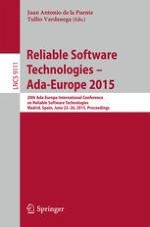2015 | Buch
Reliable Software Technologies – Ada-Europe 2015
20th Ada-Europe International Conference on Reliable Software Technologies, Madrid Spain, June 22-26, 2015, Proceedings
herausgegeben von: Juan Antonio de la Puente, Tullio Vardanega
Verlag: Springer International Publishing
Buchreihe : Lecture Notes in Computer Science
